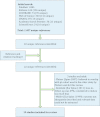The optimal treatment of type II and III odontoid fractures in the elderly: a systematic review
- PMID: 22941218
- PMCID: PMC3540294
- DOI: 10.1007/s00586-012-2452-3
The optimal treatment of type II and III odontoid fractures in the elderly: a systematic review
Abstract
Purpose: Odontoid fractures are the most common cervical spine fractures in the elderly. As the population ages, their incidence is expected to increase progressively. The optimal treatment of this condition is still the subject of controversy. The objective of this review is to summarize and compare the outcome of surgical and conservative interventions in the elderly (≥ 65 years).
Methods: A comprehensive search was conducted in nine databases of medical literature, supplemented by reference and citation tracking. Clinical status was considered the primary outcome. Fracture union and stability rates were considered secondary outcomes.
Results: A total of nineteen studies met the inclusion criteria. All studies were performed retrospectively and were of limited quality. There was insufficient data, especially from direct comparisons, to determine the difference in clinical outcome between surgical and conservative interventions. Osseous union was achieved in 66-85 % of surgically treated patients and in 28-44 % of conservatively treated patients. Fracture stability was achieved in 82-97 % of surgically patients and in 53-79 % of conservatively treated patients.
Conclusions: There was insufficient data to determine a potential difference in clinical outcome between different treatment groups. Surgically treated patients showed higher osseous union rates compared to conservatively treated patients, possibly because of different selection mechanisms. The majority of patients appears to achieve fracture stability regardless of the applied treatment. A prospective trial with appropriate sample size is needed to identify the optimal treatment of odontoid fractures in the elderly and predictors for the success of either one of the available treatments.
References
-
- Anderson LD, D’Alonzo RT. Fractures of the odontoid process of the axis. J Bone Joint Surg Am. 1974;56(8):1663–1674. - PubMed
Publication types
MeSH terms
LinkOut - more resources
Full Text Sources
Medical
Research Materials
Miscellaneous


